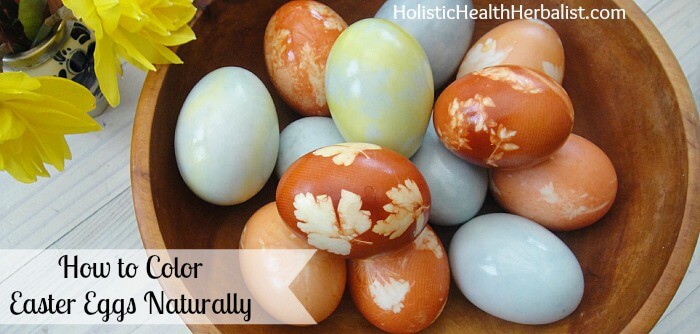Dying Easter eggs was a much beloved and avidly anticipated tradition growing up. In fact, coloring and decorating the eggs were as much fun as finding them later. I remember telling each carefully colored egg “goodbye! I’ll find you tomorrow!” before tucking them into a big wicker basket. In the morning, they would be hidden by the Easter Bunny for us kids to find.
What I remember best was the bright colors that resulted from the small kit my mother used to buy. At the time, seeing as how I was just a young child, I never stopped to think that those beautiful colors could be harmful. The sad truth? They are.
Not only are the artificial dyes used for coloring eggs expensive, they also contain harmful chemicals that can create a toxic environment, especially for young children.
The good news? You don’t need to give up tradition or stop enjoying this fun activity with your kids. There are many natural alternatives to use for natural coloring that will keep you and your kids happy and safe while coloring your eggs.
How to Color Easter Eggs Naturally
What’s really nice is you will likely have most of these ingredients on hand in your own kitchen. Coloring eggs naturally can take a bit of creativity and planning, but I promise, it will be well worth the effort!
Alright, so first things first, You will need:
• White shelled eggs
• An egg carton for drying
• White vinegar
• Salt
• Measuring spoons
• A few mason jars or bowls
• A pair of tongs
• A pot for boiling the eggs
• Cheesecloth for mottling (optional)
• Twist ties (optional)
• Small paintbrushes (optional)
• Nylon stocking (optional)
Onion Skin- Brownish Eggs with Mottling
1. For a nice mottled look, peel a brown onion and tightly wrap the skins around a raw egg until it’s fully covered.
2. Take the cheesecloth and tightly wrap the egg. Secure the cheesecloth
with a twist tie
. Make sure it’s nice and tight around the egg so that the onion skins stay as close to the shell as possible for best results.
3. Bring a quart of water with a splash of white vinegar to a boil
4. Lower the eggs into the boiling water very carefully and boil for 20 minutes
5. Remove the eggs and let them cool down a bit
6. Unwrap the eggs, and voila! You’ve got yourself a pretty brown mottled egg!
Alternatively, you could also just lower the cooled eggs into an onion skin bath.
To make this, boil the skins of several brown onions in a quart of water with ¼ cup of salt, and ¼ cup of white vinegar
. Let the eggs sit overnight to get a solid brownish color.
Red Cabbage- Bluish Eggs
Soaking cooled eggs in a red cabbage leaf bath will result in gorgeous blue colored eggs.
Use the same method as the onion skin bath and soak the eggs overnight for best results.
Turmeric- Brightly Golden Yellow Eggs
This is such a rich vibrant yellow! I absolutely LOVE this natural coloring and it’s so easy to make.
All you need is:
• 1 quart of water
• ¼ cup of salt
• ¼ cup of white vinegar
• 3 heaping TB of turmeric powder
Boil and strain the mixture then soak your cooled eggs in it overnight to make golden-colored eggs.
Red Beets- Pink Eggs
To make some bright pink eggs for the little girls in your life, simply boil up a few red beets in a quart of water with ¼ cup of salt, and ¼ cup of white vinegar. Strain the mixture into a mason jar then lower your cooled eggs into the beet concoction. Let sit overnight for pretty pink eggs.
Chlorella- Green Eggs
Chlorella is wonderful for making a lovely green colored egg.
Boil a quart of water with ¼ cup salt and ¼ white vinegar
with 3 heaping TB of chlorella
. Soak cooled eggs overnight in the mixture to achieve emerald looking eggs.
Spirulina- Blue-green Eggs
Spirulina makes really nice blue-green eggs. Use the same method as above
Other Decorating Methods for Easter Eggs
One of the most enjoyable ways to personalize your colored eggs is to use a small paintbrush for detail work by using the natural dye as “paint”. The color will not be as vibrant as soaking the eggs overnight, but the vinegar and salt
will help the colors to adhere to the shell, creating new and fun possibilities.
If you want to get extra fancy, I suggest foraging for unique leaves, petals, and flowers to wrap your egg in before soaking overnight.
The best way to do this is by using a nylon stocking to hold the flowers very close against the eggshell which will create very striking patterns that are in stark contrast with the natural dye. You can get some pretty amazing looking eggs this way. In fact, you might not want to crack them because they’re so pretty!
For more great recipes check out the articles below:
How to Decorate Easter Eggs Using Herbs and All-Natural Vegetable Dyes!
Have you ever colored eggs with natural dye alternatives?







